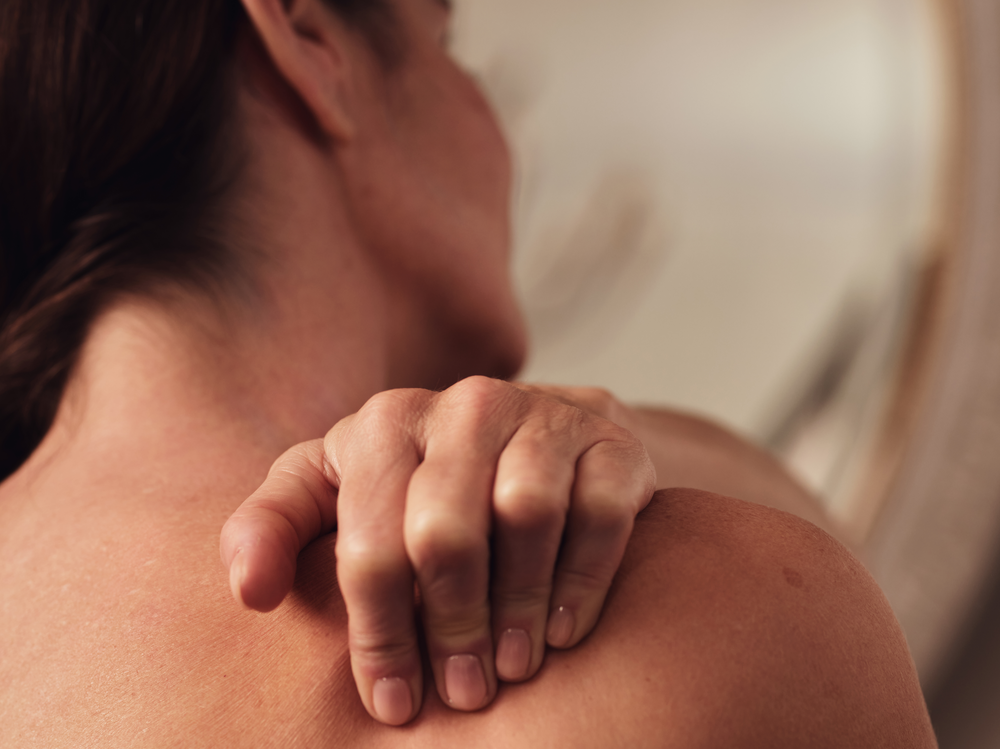Struggling with Neck and Shoulder Tension?

Are your neck and shoulders feeling the effects of hours spent in front of your screen? Or from a long-term build-up of tension and stress from long, overworked days?
Many of us suffer from pain in our necks and shoulders at some point in our lives, but we don’t always have the time to book in for a professional Aromatherapy Associates spa massage.
Luckily, there are many self-care techniques you can apply yourself at home to relieve your aching muscles.
Discover our expert self-massage to soothe fatigued muscles, ease anxiety and promote a sense of relaxation for your happiest, pain-free self.
The Benefits of a Self-Massage
The muscles in your neck and shoulders work overtime to support the weight of your head and create necessary movement.
With so many muscles and soft tissue structures in and around the neck, it is important to give these areas of our body the necessary protection and relief.
Self-massages can be used as an effective treatment for pain, as well as providing mental and emotional benefits.
1. Recovery of Muscles
The kneading motions of a self-massage improve circulation in fatigued muscles. An improvement in circulation will bring more oxygen and nutrients to problem areas, helping to alleviate cramps and pains. Loosening up neck muscles also helps to open a path for better blood flow, reducing tension headaches and migraines.
2. Reducing Anxiety and Stress
Self-massages can be used as a powerful tool to help you take charge of your health and wellbeing.
As soon as your skin’s nerve cells feel pressure and touch, they signal the brain to release feel-good chemicals otherwise known as endorphins, which elevate your mood. As a direct result of this, stress hormones cortisol and adrenaline begin to decrease, providing an overall feeling of calm and contentment and melting away your stress from the day.
3. Focusing on the Moment
A self-neck and shoulder massage enables you to take a break from whatever you are doing – to step away from the demands of life and to simply be present in the moment.
Aromatherapy Associates Global Director of Education, Christina Salcedas, swears by a self-massage:
This moment of self-care allows you to bring your attention back to the easy, natural rhythm of your breathing. As you breathe deeply, you to begin to take notice of the world around you, all while relaxing your body and subconsciously releasing tension.
Scent the scene
Create the perfect spa ambience to transform your home into a spa sanctuary with a diffusion of our De-Stress Pure Essential Oil Blend in our waterless Atomiser or Atomiser Connect.
Enjoy pure, undiluted aromas of sweet Frankincense, earthy Petitgrain and herbal Camomile essential oils to comfort and calm a racing mind, which in turn helps to physically unwind tense shoulders and relax your body.
Our Self-Massage Techniques
1. Mobilisation and stretches
First prepare your body with a generous application of our De-stress Muscle Gel - Black Pepper and Ginger essential oils work as major muscle relaxants, soothing the area with their warming effect. And Rosemary oils help to stimulate circulation.
Then perform the following mobilisations and stretches:
Start by rotating the head, from side to side.
Next, tilt the head, moving your ear to your shoulder.
Roll both shoulders backwards and then forwards.
2. Expert massage techniques
Now you're ready to apply expert techniques on specific areas of your body.
For ease of massage strokes and movements from hands to body, apply our De-Stress Body Oil all over, whilst taking in deep meditative breaths of the body oil's comforting fragrance on your skin.
Infused with therapeutic Arnica Montana Flower extract, Rosemary and the exceptional benefits of Ginger, this luxurious oil helps to reduce friction and create a smooth glide and workability to the skin’s surface, all while supporting healthy circulation.
Cranial pressures: with your index and middle fingers do small controlled circular moves to the back of the neck, starting on the right side behind the ear work towards the indentation at the base of the head, and then repeat to the left-hand side.
Spinal pressures: with index and middle fingers perform pressure points either side of the spine at the back of the neck moving up towards the indentation of the head.
Spinal slides: in the same area as above slide up to the base of the head.
Neck stroke: using both hands, stroke up towards the head.
Picking up: using fingertips and palms from the shoulders to the upper arm.
Pressure points: with index and middle finger press the indentation at the top of the shoulders working from the tip of the shoulder to the neck.











